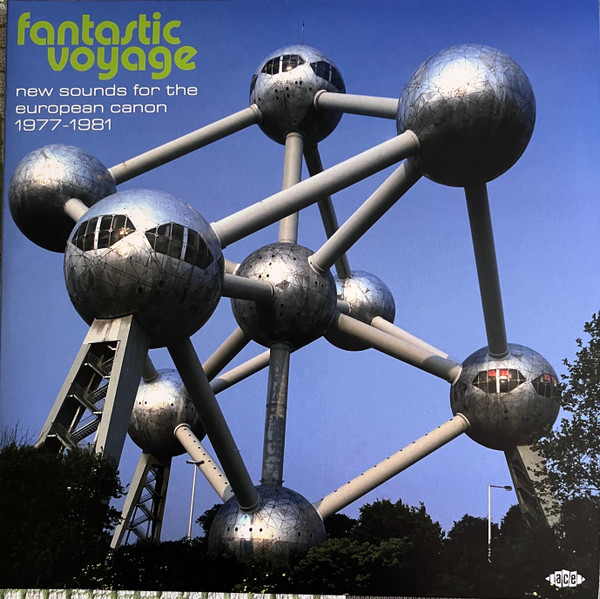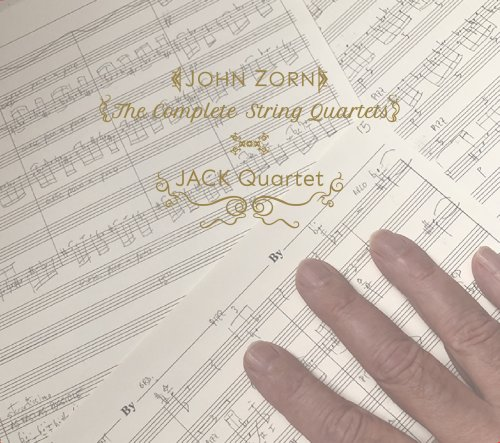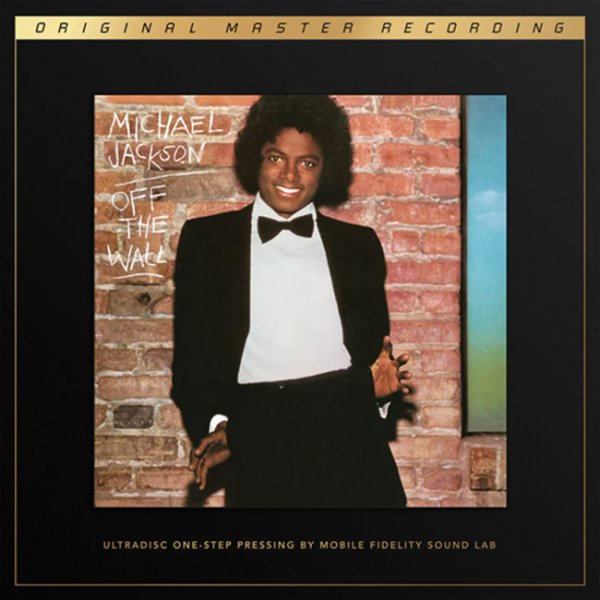What is new in my music library? (recent purchases I enjoy)
- Thread starter flez007
- Start date
You are using an out of date browser. It may not display this or other websites correctly.
You should upgrade or use an alternative browser.
You should upgrade or use an alternative browser.
I wonder what this music has to do with Thailand or with its temple mural arts as seen on this record cover.Christopher Adler - Epilogue for a Dark Day
Modern Avant garde Classical & Folk on Tzadik label. A Fascinating release from 2004
View attachment 144108
"A Californian (San Diego) having traveled to the Pacific Rim frequently, Christopher Adler is perhaps one of the more unique modern composers of the 21st century. He combines traditional folk music of Thailand and Laos with the post-John Cage contemporary minimalist school. The result is a stunning music sporting unique instrumentation, timbres and tones that reflect an affinity for electronic music, and an acoustic esthetic that is sonorous, at times shimmering, and definitely spiritual. Adler plays two pieces on the khaen, an internal reed instrument with 16 bamboo pipes mounted in a wooden windchest, native to the Lao culture of Laos and northeastern Thailand. Its sound assimilates a harmonica with overtones of a drone similar to bagpipes, yet it retains a multi-harmonic resonance that might be the cousin of the ba-hu or forefather of the melodica or harmonium. "The Wind Blows Inside" is church-like and meditational but minimalist and not unlike Terry Riley's "Persian Surgery Dervishes." The title track, recorded five months after 9/11, seems naturally somber, at times inquisitive, sighing and breathing deeply. "Three Lai" adds violin and viola and displays a definite traditional dance quality before waxing romantic, then ending in a bouncy canon. The influence of Lou Harrison's gamelan experiments is quite evident during the outstanding "Signals Intelligence" played by the Red Fish Blue Fish percussion sextet. A very regimented but interactive piece, it incorporates the shifting rhythms, moods, and accents so typical of Asian music, with a booming bass drum or 7/8 rhythm tossed in. The magnum opus "Pan-Lom" is a musical essay on architecture that Adler offered for his PhD dissertation at Duke University. Meaning "to sculpt the wind," the live in studio (no overdubs) 23-minute piece with a 13-piece acoustic band and samples added has Adler on Thai xylophone, again quite regimented but more spectral and varied in emotional content, ranging from direct and historical to serene, dancing, and joyous, then calming. A violin solo by Eric Pritchard is placed in the middle on a composition also quite similar to what Lou Harrison might do with these exotic and standard instrumental combinations. It is a triumphant, regal, and proud world music statement, unique unto itself, and should be in the collection of all interested in any Indo-jazz or ethnic fusion events of recent documentation.I wonder what this music has to do with Thailand or with its temple mural arts as seen on this record cover.
© Michael G. Nastos"
Just found some track samples from this recording on Discogs. Very interesting modern (avant-garde??) use of traditional Thai instruments. Living here for 40 years, I have often heard these instruments in their more traditional contexts but this is something quite different, meditative as your article says. Also noticed that there are no Thai musicians performing on this. This was produced by John Zorn, an artist I have followed for years."A Californian (San Diego) having traveled to the Pacific Rim frequently, Christopher Adler is perhaps one of the more unique modern composers of the 21st century. He combines traditional folk music of Thailand and Laos with the post-John Cage contemporary minimalist school. The result is a stunning music sporting unique instrumentation, timbres and tones that reflect an affinity for electronic music, and an acoustic esthetic that is sonorous, at times shimmering, and definitely spiritual. Adler plays two pieces on the khaen, an internal reed instrument with 16 bamboo pipes mounted in a wooden windchest, native to the Lao culture of Laos and northeastern Thailand. Its sound assimilates a harmonica with overtones of a drone similar to bagpipes, yet it retains a multi-harmonic resonance that might be the cousin of the ba-hu or forefather of the melodica or harmonium. "The Wind Blows Inside" is church-like and meditational but minimalist and not unlike Terry Riley's "Persian Surgery Dervishes." The title track, recorded five months after 9/11, seems naturally somber, at times inquisitive, sighing and breathing deeply. "Three Lai" adds violin and viola and displays a definite traditional dance quality before waxing romantic, then ending in a bouncy canon. The influence of Lou Harrison's gamelan experiments is quite evident during the outstanding "Signals Intelligence" played by the Red Fish Blue Fish percussion sextet. A very regimented but interactive piece, it incorporates the shifting rhythms, moods, and accents so typical of Asian music, with a booming bass drum or 7/8 rhythm tossed in. The magnum opus "Pan-Lom" is a musical essay on architecture that Adler offered for his PhD dissertation at Duke University. Meaning "to sculpt the wind," the live in studio (no overdubs) 23-minute piece with a 13-piece acoustic band and samples added has Adler on Thai xylophone, again quite regimented but more spectral and varied in emotional content, ranging from direct and historical to serene, dancing, and joyous, then calming. A violin solo by Eric Pritchard is placed in the middle on a composition also quite similar to what Lou Harrison might do with these exotic and standard instrumental combinations. It is a triumphant, regal, and proud world music statement, unique unto itself, and should be in the collection of all interested in any Indo-jazz or ethnic fusion events of recent documentation.
© Michael G. Nastos"
I picked up the special edition Waka/Jawaka, Apostrophe, and Overnite Sensation records during the end-of-year extravaganza over at UDiscover Music. I also have been spending my kid's inheritance on the Deutsche Grammophon Original Source Series - listened to Grieg's Peer Gynt Suite 1 last night - goosebump city over here.
"Double vinyl LP pressing. UK collection. By the turn of the 80s, the impact of David Bowie's ground-breaking Berlin recordings - the synths, the alienation, the drily futuristic production - was being felt on music across Europe. What's more, the records being made were reflecting back and influencing Bowie's own work - 1979's "Lodger" and 1980's "Scary Monsters" owed a debt to strands of German kosmische (Holger Czukay), new electronica (Patrick Cowley, Harald Grosskopf), and the latest works from old friends and rivals like Robert Fripp, Peter Gabriel and Scott Walker, all of whom had been re-energised by the fizz of 1977. Compiled by Saint Etienne's Bob Stanley and the BFI's Jason Wood, "Fantastic Voyage" is the companion album to their hugely successful "Café Exil" collection, which imagined the soundtrack to David Bowie and Iggy Pop's trans-European train journeys in the mid-to-late seventies. "Fantastic Voyage" is what happened next. Bowie's influences and Bowie's own influence were rebounding off each other as the 70s ended and the 80s began, notably in the emergent synthpop and new romantic scenes as well as through the music of enigmatic acts like the Associates and post-punk pioneers such as Cabaret Voltaire. Like "Low" and "Heroes", some of the tracks on "Fantastic Voyage" are spiked with tension (Grauzone's 'Eisbär') while some share those albums' sense of travel (Simple Minds' 'Theme for Great Cities', Ryuichi Sakamoto's 'Riot in Lagos') and others find common ground with "Lodger's" dark, subtle humour (Thomas Leer's 'Tight as a Drum', Fripp's 'Exposure'). This is the thrilling, adventurous sound of European music before the watershed moment when Bowie would abandon art-pop for America and the emerging world of MTV with "Let's Dance" in 1983. "Fantastic Voyage" soundtracks the few brief years when the echo chamber of Bowie, his inspirations, and his followers created an exciting, borderless music that was ready to challenge Anglo American influences."


Santi Careta – A milers de somnis de distància
"Santi Careta is an intriguing Catalan musician. Contributing to bands like Astrio, Rodrigo Laviña y Su Combo and Alba Careta i Henrio, Careta moves swiftly between jazz, pop-rock and experimental settings, proving just as comfortable in a classical environment as with electronics. But it is perhaps in his singer-songwriter skin that Careta fully blooms as an idiosyncratic troubadour.
A Milers de Somnis de Distància (A Thousand Dreams Away) is a stunning set of songs focussed on ‘various forms of distancing.’ Folky at their core, these songs often carry a stranger twist – ‘Sol Sol’ and ‘A Milers de Somnis de Distància’ are two extraordinary examples of Careta’s ability to navigate through delicate songs with a somewhat unsettling feeling.
Santi Careta is surely acquainted with the indie folk of Sufjan Stevens, Bon Iver, Rodrigo Amarante and Elliott Smith, but he spices up his delicate signature on A Milers de Somnis de Distància with some occasional and quite fitting hip-hop rhythm figures (‘Parla’m’) and a horn quartet (‘Brúixola’). — songlines.co.uk""

"Santi Careta is an intriguing Catalan musician. Contributing to bands like Astrio, Rodrigo Laviña y Su Combo and Alba Careta i Henrio, Careta moves swiftly between jazz, pop-rock and experimental settings, proving just as comfortable in a classical environment as with electronics. But it is perhaps in his singer-songwriter skin that Careta fully blooms as an idiosyncratic troubadour.
A Milers de Somnis de Distància (A Thousand Dreams Away) is a stunning set of songs focussed on ‘various forms of distancing.’ Folky at their core, these songs often carry a stranger twist – ‘Sol Sol’ and ‘A Milers de Somnis de Distància’ are two extraordinary examples of Careta’s ability to navigate through delicate songs with a somewhat unsettling feeling.
Santi Careta is surely acquainted with the indie folk of Sufjan Stevens, Bon Iver, Rodrigo Amarante and Elliott Smith, but he spices up his delicate signature on A Milers de Somnis de Distància with some occasional and quite fitting hip-hop rhythm figures (‘Parla’m’) and a horn quartet (‘Brúixola’). — songlines.co.uk""

Thanks for this recommendation. Just ordered a CD of the concertos on Chandos.Premiere recording, quite complex and excellent to say the least!!! A must-own for any baroque music lover.
View attachment 143793
Reviewed by a fellow music lover on the Amazon's web site.
"John Fowler-
Original Recordings of Music Banned by the Nazis
Reviewed in the United States on 2 July 2015
The Nazis were infamous for banning music by Jewish and politically dissident composers and performers.
This 10 CD box, imported from Germany, contains the original recordings that the Nazis found so offensive.
176 individual recordings - Ninety percent recorded between 1930 and 1933, the final years of the German republic.
Half of it is German popu lar music of the Twenties and early Thirties.
lar music of the Twenties and early Thirties.
The rest are classical selections, with a lot of Operetta crossover.
The transfers from ancient 78rpm records are very well done.
There is a 64 page booklet (32 pages in German, 32 in English) with detailed notes about the composers and performers.
A bit disorganized, but with so much information this is inevitable.
Some musicians (Marlene Dietrich, Comedian Harmonists, Friederich Hollaender) make as many as ten appearances each, but to save space they get only one biographical entry.
A lot of cross-referencing and searching back and forth in the booklet.
No texts or translations for the vocal works.
They are sorely missed - especially in the cabaret songs, but this seems inevitable in a box of this scope and at this price.
CD 1: CULTURAL BOLSHEVISM - DEGENERATE MUSIC "And the shark's teeth may be lethal"
Political Theater by Kurt Weill, Friederich Hollaender, Hans Eisler, Ernst Krenek, and Mischa Spoliansky.
The 1930 excerpts from Weill's "Dreigroschenoper" (Three Penny Opera) document the original cast (Lotte Lenya, Kurt Gerron) of a Twentieth Century masterpiece,
plus Otto Klemperer's conducting of Kleine Dreigroschenmusik from 1931.
Additional excerpts are available on other labels. *
FOUR CDs OF CABARET AND POPULAR SONG:
CD 2: CABARET, CHANSON "It's always the fault of the Jews"
CD 3: LAX MORALS "The versatility of love"
CD 4: TOTAL LICENCE "Falling in love again"
CD 5: HIT SONGS AND FILMS "What y'doin with your Knee"
-- "It's always the fault of the Jews" ("An allem sind die Juden schuld") - CD 2, track 1.
Lyrics by Friederich Hollaender set to the Habanera from Bizet's Carmen (rec. 1932) - Truly Bizarre.
The next to last line sounds like "und Herr Einstein ging vorbei" which I think means "and Mr. Einstein goes away".
I would dearly love to find a translation of whole song.
-- "What y'doin with your Knee" ("Was machst du mit dem knie, lieber Hans?") - CD 5, track 1.
A translation of this could also be interesting.
CD 6: OPERETTA "You are my heart's delight"
CD 7: OPERETTA "There is a land of fancy"
This was the "Silver Age" of Operetta: Benatzky, Fall, Kalman, Lehar, Stolz, and Oscar Straus, plus some "Golden Age" stuff from Johann Strauss.
-- Emmerich Kalman and Oscar Straus were Jews who left Germany (Leo Fall was Jewish, but he died in 1925). Their works were blacklisted.
-- Johann Strauss had Jewish ancestry, but rather than blacklist him, the Nazis forged documents covering this up.
-- Franz Lehar was married to a Jewess (this term is used in the booklet) and his preferred interpreters were Jewish.
Lucky for him, he was also Hitler's favorite composer.
-- Unexpected delight: All this German schmaltz is interrupted by Otto Klemperer's joyous romp through Offenbach's La Belle Helene Overture (CD 6, track 6), recorded in 1929.
If nothing else, Otto Klemperer is the most interesting conductor of the Twentieth Century. **
CD 8: OPERA "Ah, I sense that it has vanished"
CD 9: OPERA "I know a violent race"
New York's Metropolitan Opera was the unintended beneficiary of Hitler's persecution of Jewish singers.
Most of these 78rpm records will be familiar to collectors.
Jewish composers were also blacklisted: Meyerbeer from the Nineteenth Century, Erich Wolfgang Korngold from the Twentieth (his ultimate destination was Hollywood)
Everything is sung in German: "Der Bajazzo" = "Pagliacci"
CD 10: CONCERT "On wings of song into exile"
Classical music performed by exiles - most of this has already been released on other labels:
Mahler conducted by Bruno Walter and Jascha Horenstein, plus Paul Hindemith, Erich Kleiber, Artur Schnabel, Fritz Kreisler, Adolf and Fritz Busch etc.
Even Robert Schumann's 1840 setting of Dichterliebe was banned because the poet Heine was Jewish.
-- Confession: I normally go to great lengths to avoid listening to German Cabaret Songs,
but I'm glad I bought this collection.
Depressing at times, but educational.
Recommended to students of history and music alike.
And its doesn't cost a lot.
----------------------------------------------------------
* Here is the fullest selection of the 1930 Dreigroschenoper excerpts recorded by Telefunken:
Weill: The Threepenny Opera - Berlin 1930 - or
Die Dreigroschenoper (The Threepenny Opera); Berlin 1930
(contents are identical, and both versions include texts and translations).
Lotte Lenya re-recorded Die Dreigroschenoper in stereo in the late '50s.
But by then her voice had lost it's girlish soprano, and had evolved into a manly contralto (too many cigarettes): Weill: The Threepenny Opera (Die Dreigroschenoper)
[ She also played SMERSH agent Rosa Kleb in the second James Bond film "From Russia with Love" (1962). ]
** Otto Klemperer's (born 1885) career lasted until 1971, well into the stereo era.
He re-recorded Kurt Weill's Kleine Dreigroschenmusick in stereo in 1961: 20th Century Music
Every bit as decadent as his 1931 recording.
"John Fowler-
Original Recordings of Music Banned by the Nazis
Reviewed in the United States on 2 July 2015
The Nazis were infamous for banning music by Jewish and politically dissident composers and performers.
This 10 CD box, imported from Germany, contains the original recordings that the Nazis found so offensive.
176 individual recordings - Ninety percent recorded between 1930 and 1933, the final years of the German republic.
Half of it is German popu
 lar music of the Twenties and early Thirties.
lar music of the Twenties and early Thirties.The rest are classical selections, with a lot of Operetta crossover.
The transfers from ancient 78rpm records are very well done.
There is a 64 page booklet (32 pages in German, 32 in English) with detailed notes about the composers and performers.
A bit disorganized, but with so much information this is inevitable.
Some musicians (Marlene Dietrich, Comedian Harmonists, Friederich Hollaender) make as many as ten appearances each, but to save space they get only one biographical entry.
A lot of cross-referencing and searching back and forth in the booklet.
No texts or translations for the vocal works.
They are sorely missed - especially in the cabaret songs, but this seems inevitable in a box of this scope and at this price.
CD 1: CULTURAL BOLSHEVISM - DEGENERATE MUSIC "And the shark's teeth may be lethal"
Political Theater by Kurt Weill, Friederich Hollaender, Hans Eisler, Ernst Krenek, and Mischa Spoliansky.
The 1930 excerpts from Weill's "Dreigroschenoper" (Three Penny Opera) document the original cast (Lotte Lenya, Kurt Gerron) of a Twentieth Century masterpiece,
plus Otto Klemperer's conducting of Kleine Dreigroschenmusik from 1931.
Additional excerpts are available on other labels. *
FOUR CDs OF CABARET AND POPULAR SONG:
CD 2: CABARET, CHANSON "It's always the fault of the Jews"
CD 3: LAX MORALS "The versatility of love"
CD 4: TOTAL LICENCE "Falling in love again"
CD 5: HIT SONGS AND FILMS "What y'doin with your Knee"
-- "It's always the fault of the Jews" ("An allem sind die Juden schuld") - CD 2, track 1.
Lyrics by Friederich Hollaender set to the Habanera from Bizet's Carmen (rec. 1932) - Truly Bizarre.
The next to last line sounds like "und Herr Einstein ging vorbei" which I think means "and Mr. Einstein goes away".
I would dearly love to find a translation of whole song.
-- "What y'doin with your Knee" ("Was machst du mit dem knie, lieber Hans?") - CD 5, track 1.
A translation of this could also be interesting.
CD 6: OPERETTA "You are my heart's delight"
CD 7: OPERETTA "There is a land of fancy"
This was the "Silver Age" of Operetta: Benatzky, Fall, Kalman, Lehar, Stolz, and Oscar Straus, plus some "Golden Age" stuff from Johann Strauss.
-- Emmerich Kalman and Oscar Straus were Jews who left Germany (Leo Fall was Jewish, but he died in 1925). Their works were blacklisted.
-- Johann Strauss had Jewish ancestry, but rather than blacklist him, the Nazis forged documents covering this up.
-- Franz Lehar was married to a Jewess (this term is used in the booklet) and his preferred interpreters were Jewish.
Lucky for him, he was also Hitler's favorite composer.
-- Unexpected delight: All this German schmaltz is interrupted by Otto Klemperer's joyous romp through Offenbach's La Belle Helene Overture (CD 6, track 6), recorded in 1929.
If nothing else, Otto Klemperer is the most interesting conductor of the Twentieth Century. **
CD 8: OPERA "Ah, I sense that it has vanished"
CD 9: OPERA "I know a violent race"
New York's Metropolitan Opera was the unintended beneficiary of Hitler's persecution of Jewish singers.
Most of these 78rpm records will be familiar to collectors.
Jewish composers were also blacklisted: Meyerbeer from the Nineteenth Century, Erich Wolfgang Korngold from the Twentieth (his ultimate destination was Hollywood)
Everything is sung in German: "Der Bajazzo" = "Pagliacci"
CD 10: CONCERT "On wings of song into exile"
Classical music performed by exiles - most of this has already been released on other labels:
Mahler conducted by Bruno Walter and Jascha Horenstein, plus Paul Hindemith, Erich Kleiber, Artur Schnabel, Fritz Kreisler, Adolf and Fritz Busch etc.
Even Robert Schumann's 1840 setting of Dichterliebe was banned because the poet Heine was Jewish.
-- Confession: I normally go to great lengths to avoid listening to German Cabaret Songs,
but I'm glad I bought this collection.
Depressing at times, but educational.
Recommended to students of history and music alike.
And its doesn't cost a lot.
----------------------------------------------------------
* Here is the fullest selection of the 1930 Dreigroschenoper excerpts recorded by Telefunken:
Weill: The Threepenny Opera - Berlin 1930 - or
Die Dreigroschenoper (The Threepenny Opera); Berlin 1930
(contents are identical, and both versions include texts and translations).
Lotte Lenya re-recorded Die Dreigroschenoper in stereo in the late '50s.
But by then her voice had lost it's girlish soprano, and had evolved into a manly contralto (too many cigarettes): Weill: The Threepenny Opera (Die Dreigroschenoper)
[ She also played SMERSH agent Rosa Kleb in the second James Bond film "From Russia with Love" (1962). ]
** Otto Klemperer's (born 1885) career lasted until 1971, well into the stereo era.
He re-recorded Kurt Weill's Kleine Dreigroschenmusick in stereo in 1961: 20th Century Music
Every bit as decadent as his 1931 recording.
Last edited:
Similar threads
- Replies
- 5
- Views
- 255
- Replies
- 10
- Views
- 2K
- Replies
- 71
- Views
- 12K
- Replies
- 20
- Views
- 4K
| Steve Williams Site Founder | Site Owner | Administrator | Ron Resnick Site Owner | Administrator | Julian (The Fixer) Website Build | Marketing Managersing |












